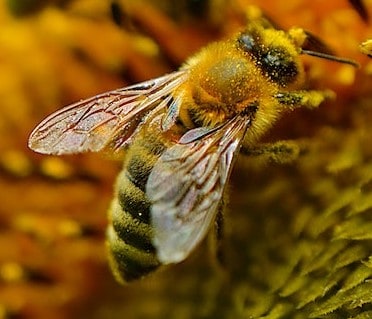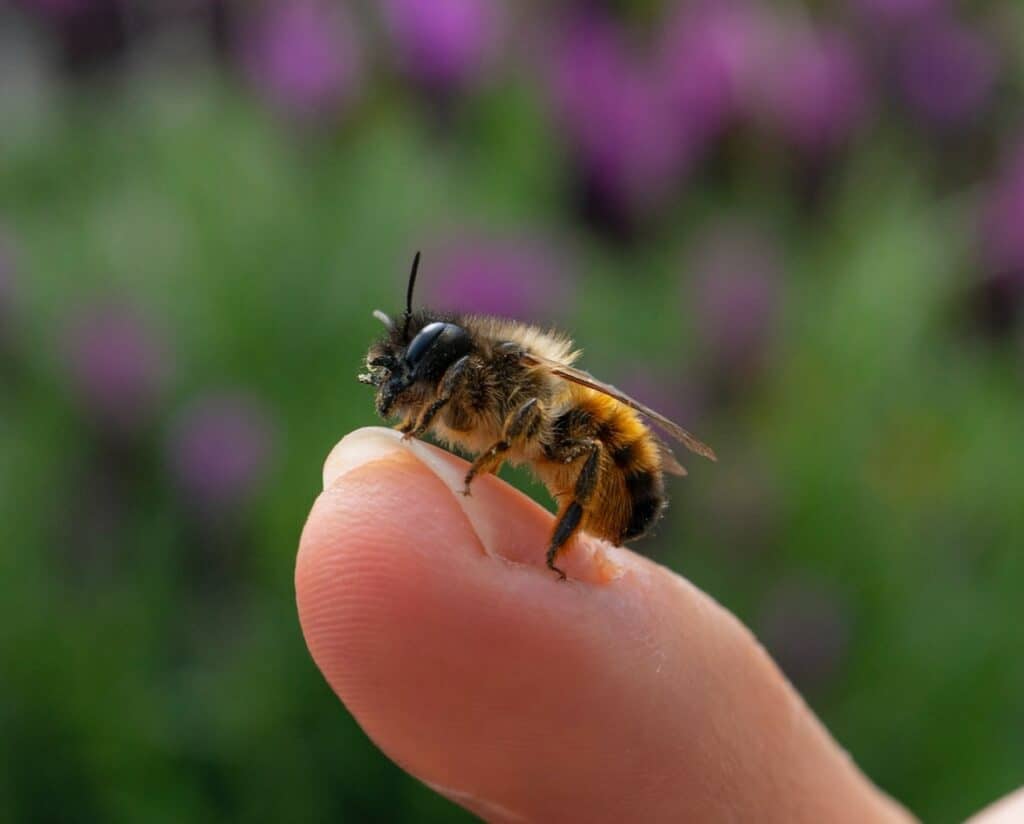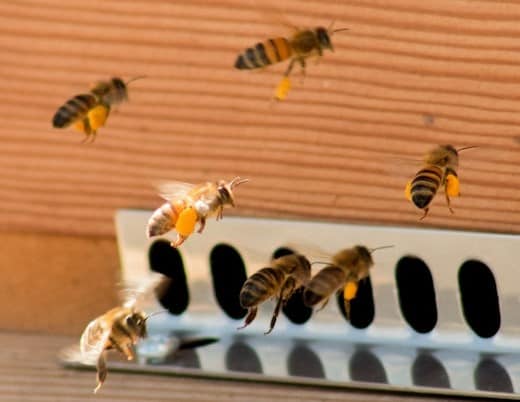In the bee world, we like to keep it simple. So, we name you for what you are best known for. This is why bumble bees and honey bees are named differently.
Leafcutter bees cut leaves. Carpenter bees drill holes in wood. Mason bees build their houses from the dirt. And sweat bees love human sweat. You get the idea.
The bumble bee is known more for its loud, low buzz, while the honey bee is known for the nectar syrup we like to drizzle on our favorite pastries.
There are other differences between bumble bees and honey bees, some subtle and others glaring, that we shall explore as well.
Bumble Bees vs. Honey Bees: Size and Shape
One major difference between a bumble bee and a honey bee is their looks.
Bumblebees are slightly bigger with a more fuzzy appearance than honey bees. Their hairy bodies are superbly equipped for the pollen-collecting job they are known for.

Honey bees have less hair, which is why there are so many cases of mistaken identity between them and wasps, such as yellow jackets. Honey bees are also a little slender, and you can see the head and thorax are clearly separate.

Bumblebees, on the other hand, look like the head and thorax are one. Unless you get really close, you can’t tell where the head ends and the thorax begins.
Bumble Bee vs. Honey Bee: Nests
When we live it up to nature, honey bees live in hives far from the reach of men. Honey bees like to live it up, literally.
If a beekeeper or enthusiast doesn’t set up a beehive for them, they’ll settle for a cave, the space in your roof, or a hollowed tree. They keep above ground.
When you plan to accumulate large amounts of honey stores, you definitely want to keep it safe. Unfortunately, some of their common predators are prowlers, such as ants, skunks, and bears.
Having honey bee hives above ground allows the bees to employ gravity as a defense. I’ll give you an example. The giant honey bees of Nepal build their bee hive on cliffs that require prospective honey hunters to climb over 1000 ft to get at the honey.
If you have a fear of heights, a swarm of very angry defensive bees won’t help you overcome your fear. That eliminates a number of potential predators.
On the other hand, bumble bees nest underground. They find abandoned burrows, where they build a bumble bee nest.
Although they do produce honey, they do so in small quantities. Very few members of the colony need to survive the winter, and they each go their separate ways and fend for themselves. They also sleep through the winter, so there is no need for large stores.
Bumble Bees vs. Honey Bees: Domestication
In the beekeeping community, bumble bees are still known to be wild insects and have not undergone as much genetic modification as honey bees have. Bumble bees are like wolves, while honey bees are like Labradoodles.
Over time, breeders have grafted bees for their various traits, including honey production, temperament, and, recently, varroa tolerance.
As a result, you’ll find that some honey bees will be more tolerant of your constant intrusion than a nest of bumble bees would.
Bumble Bee vs. Honey Bee: Stings

Bumble bees don’t have the numbers that their cousins have yet and have been armed with the same weapon, a stinger.
Nature has thus seen fit to boost bumblebees with the ability to sting multiple times. Meanwhile, their counterparts only get that one chance.
If they happen to waste it on your glove, so be it. Then again, when you have 50,000 sisters, you can afford to waste a sting or two because a few thousand are bound to hit their mark.
The effect of the sting on the body is similar and is most dangerous if you suffer from an allergic reaction to bee stings. Death by a honey bee is more common than bumblebee because of the numbers involved.
Africanized bees, for instance, send out more than half the colony when they are under threat.
Bumble Bee vs. Honey Bee: Numbers
Bumblebees start off with just one queen. She’s a lone ranger who finds some good real estate and settles.
She builds cells to lay her eggs and cares for them until they are old enough to start caring for others. This is when she delegates most of her homecare duties and focuses on laying the eggs. She only has a few months to do this because she’ll be gone by winter to make way for some of her daughters to become queens.
The life of a honeybee queen is truly one of entitlement. She doesn’t travel without an entourage, which is what a swarm is.
When the old queen leaves with worker bees, the new queen isn’t left alone. If she were, she would starve. She has enough labor to take care of herself, her young, and the whole honey bee hive.
The sole responsibility of the queen bee is to lay eggs. She doesn’t build combs, doesn’t clean up, doesn’t do laundry, or nurse the babies. That is left to her daughters, the worker bees.
As social insects, honeybees survive through the winter because they form clusters to keep each other warm.
Warmth is definitely a game of numbers. The more they are, the more heat they generate. Strong honey bee colonies would have bees that number in the tens of thousands, while bumblebees will only have a few hundred bees in a nest.

Bumble Bee vs. Honey Bee: Over Winter
Who doesn’t like a good cuddle when the temperatures drop? Well, it would seem that the bumblebee doesn’t care too much for bundling together with its sisters or daughters during the winter months.
In late summer, a bumble bee will lay the next generation of queens and drones. Previously, she was just laying little helpers whose purpose was to carry pollen and nectar as food for the young and care for their siblings.
Now, she’s getting ready to pass on the species torch. When the new queens emerge, they go and mate. As fall begins, they feed in order to get enough fat to last through the winter.
By the time the temperatures drop, each queen will find her own safe space where she will sleep away the chill and emerge in spring.
Honeybees do not hibernate. They reduce their outdoor activities as fall gives way to winter, but they are still conscious in the hive, moving and eating until the weather allows them to leave the safety of their nests. This is why they need to store whatever type of honey.
Unlike bumble bees, which store the food they need inside their exoskeletons, honey bees build a pantry to store excess honey to sustain the entire colony throughout the winter.

Final Thoughts
Bumble bees and honey bees may be quite similar at first glance. But now, you would know that there are several key differences between these two bee species.
No matter their differences, these two species, along with other bees, are excellent at buzz pollination.
Farmers, gardeners, and beekeepers value their presence as they buzz from the flowers of many plants. They play a crucial role in our ecosystem as better pollinators compared with other flying insects.


Thank you so much. What detailed info.
Thank you for the detailed information. It’s simple enough that my son understood the comparison.
Thank you, I have long been fascinated with bumblebees. They have gotten on our flowers and I have found if you are very slow and gentle you can actually reach out and touch them with your finger. This has fascinated my grandkids. We have many bees here but I have never seen a hive, I would think it is in the woods we keep and rarely venture into. I enjoy seeing them in the summer and so do my flowers and vegetables.
Wow I’m so jealous that you can touch them
I notice a difference in the preferred flowers of Bumble bees as compared to honeybees.
My garden has mainly lupines, English lavender and calendula. The honey bees ignore the lupines & lavender, while the Bumbles love them. The honey bees like the calendula.
I don’t understand why that is because the Bumbles fly away just loaded with pollen.
Bees are not hairy. They have feathers.
Very informative. Thank you. What you said about bumble bees making a nest in an abandoned burrow is true. Also, multiple stings. Unknown to me, there was a nest of bumble bees, a few like you said, in an abandoned chipmunk hole right at the edge of a concrete slab that I walked over. Off of my patio. I got a exterminator out the next day and he thought they were honey bees. Young guy, I got a bee keeper out the same day and he said nope! Bumble bees. He said what you said about the differences between bumble bees and honey bees. Your information is more in depth though.
I’m so curious about bees. Thanks for the detailed information.
Hi I am Tom in New Zealand.
We often saw the odd Bumble bee in the past few years, but this year we have what looks like a family. Every afternoon they come 4 of them and spend hours on one plant, I do not know the plant but it has purple flowers and they have come to that plant for the last 2 or 3 weeks.
I will try to find out the name of the plant. But as the flowers reach up the stems the previous little pod open so I have put a tray under the plant with compost in it to catch the seeds and hopefully propagate more for next year.
I just love watching them while I have a beer.
We have bumble bees, honey bees and carpenter bees. The most aggressive is the carpenter bees with how they dive bomb us and burrow into our cedar-sided garage with huge holes. But they haven’t stung us. I’ve never been afraid of American bees…they dont typically sting. In fact, my black and white long-haired husky-boy, Corey, touched a couple very fluffy bright yellow and black bumble bees with his nose over 2-3 summers. They just shook him off—as if scolding him that they were too busy for his nonsense— and kept drinking their nectar in the cucumber and broccoli flowers. He was so intrigued with them every year! Then when he passed, we got Budbud, our all-white husky, and he also touched one of our fluffy bright yellow/black bumble bees with his nose! I finally got tired of them having all the fun and I ‘pet’ a few bright fluffy bumbles also. They never ever sting us. The honey bees are adorable, but they aren’t as fluffy so we dont try to pet them. The carpenter bees are the size of my big toes and they are monsters. Those beasts swoop at us every year and take over our garage and make huge holes in our garage and cedar fence…at least 1 inch around. We basically ignore them or swat them away but still they haven’t ever stung any of us. However, the yellow jacket armies…we worked hard to redo all our gutters and facia and other places in the house structure to eliminate them – they are just evil and sting everyone they can get to. Bring on our sweet honey bees and bumbles in suburban-Chicago!
I think I may have a bumblebee hive under the main floor of my house. At the end of summer last year I noticed a few bees going in and out a crack. Between today and yesterday I have safely removed 6 big bumble bees from my downstairs. I’ve had no doors open or windows so no way that half a dozen bumblebees could get in. I don’t mind them being where they are but I do have a 2 year old who wants to take a closer look at them but I don’t want to scare her from them either. What should I do